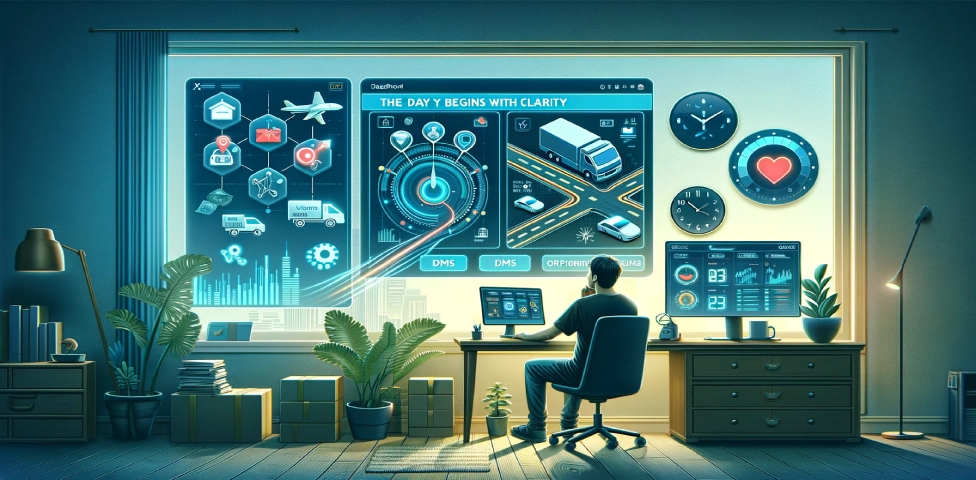In the fast-paced world of logistics and delivery, the right technology can make all the difference. “How does a Delivery Management System work?” This question is key to understanding the revolution in the logistics sector. A Delivery Management System (DMS) stands at the forefront, bringing efficiency and ease to what was once a logistical nightmare. Follow a day in the life of Alex, a logistics manager focused on boosting productivity, to see this transformation in action.
Morning: The Day Begins with Clarity
Alex’s day starts with a quick check of the DMS dashboard. He instantly has a clear picture of the day’s deliveries, driver assignments, and vehicle statuses. The system’s automated scheduling and route optimization features have already planned the most efficient routes, taking into account traffic conditions, delivery windows, and load capacities. This seamless start saves Alex considerable planning time, allowing him to focus on more strategic tasks.

Mid-Morning: Real-Time Coordination and Adjustment
As the deliveries kick off, Alex monitors the progress in real-time through the DMS. When an urgent delivery request comes in, aimed at Boosting Productivity, he uses the system to identify the nearest driver with the right capacity. With just a few clicks, the new order is dispatched, and the route is dynamically adjusted. This flexibility and real-time responsiveness are crucial for meeting customer expectations and handling the unpredictable nature of delivery operations.

Lunchtime: Data at His Fingertips
Even during his lunch break, Alex stays informed. The accessibility of the DMS means he can quickly check on status updates or respond to any issues. The system’s real-time notifications keep him in the loop, a freedom that was unthinkable before the integration of the DMS.

Afternoon: Customer Satisfaction in Real-Time
In the afternoon, Alex focuses on customer interactions, with a keen eye on Boosting Productivity. The DMS provides customers with live tracking information and estimated times of arrival, significantly enhancing the customer experience. Alex monitors customer feedback through the system, addressing any concerns promptly. This direct line of communication, powered by the DMS, has led to a noticeable improvement in customer satisfaction and loyalty.

Late Afternoon: Efficiency Analysis and Feedback
As the day’s deliveries wind down, Alex uses the analytical tools in the DMS to review performance metrics. He examines delivery times, driver efficiency, and customer feedback, identifying areas for improvement. This data-driven approach enables him to make informed decisions on optimizing operations, such as adjusting driver schedules or reallocating resources for better efficiency.

Evening: Planning for Tomorrow
Before ending his day, Alex sets up the schedule for the next day. With the DMS’s predictive analytics, aimed at Boosting Productivity, he can forecast delivery volumes and plan accordingly. This proactive planning capability helps in managing resources effectively and ensuring that they are always prepared for the challenges of the next day.
Conclusion
It’s Here is a cloud-based software company in Coquitlam, BC, specializing in optimizing logistics through a range of tools, including our delivery management system. “How does a Delivery Management System work?” It seamlessly integrates with our suite, streamlining the entire logistics process. Our applications, available via subscription, also include an appointment scheduler, sorting hub WMS, and fulfillment WMS. Book a FREE demo to explore popular features.
FAQs About Using a Delivery Management System (DMS)
1. What is a Delivery Management System (DMS)?
A Delivery Management System (DMS) is a software solution that streamlines the process of managing and optimizing the delivery of goods. It covers everything from order tracking, route planning, to real-time delivery updates, ensuring efficient and timely distribution.
2. How does a DMS improve delivery operations and Boosting Productivity,?
A DMS enhances delivery operations by optimizing routes, providing real-time tracking, automating dispatch processes, and improving communication between drivers, dispatchers, and customers. This results in faster deliveries, reduced operational costs, Boosting Productivity, and improved customer satisfaction.
3. Is customer communication integrated into a DMS?
Absolutely. A DMS often includes customer communication features like real-time delivery tracking links, estimated time of arrival notifications, and feedback collection tools, enhancing the customer experience.





